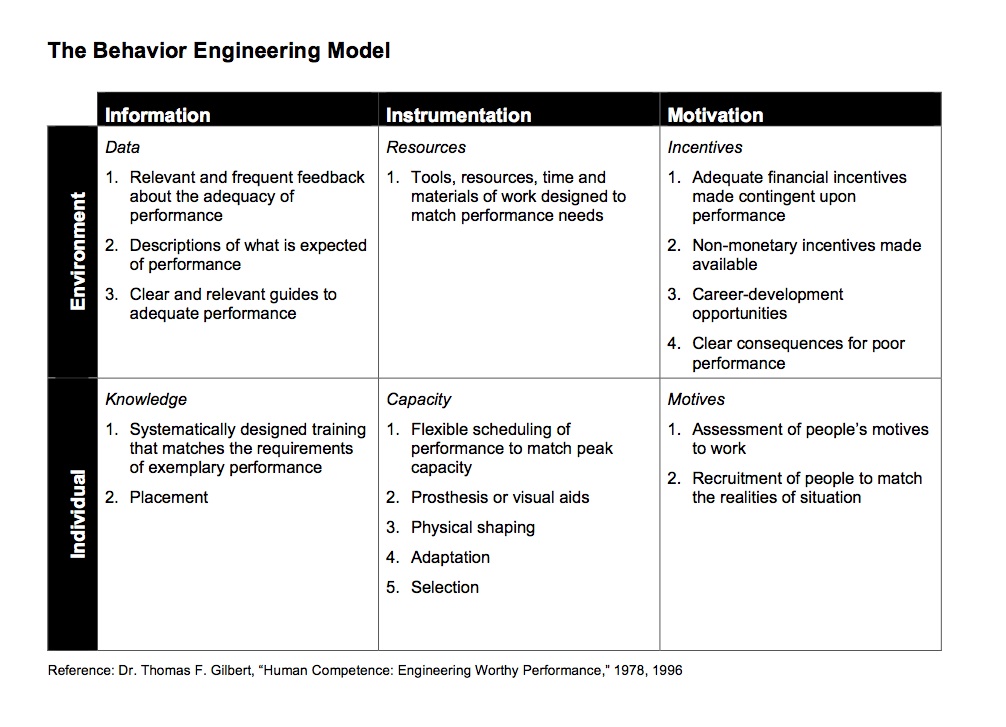Lesson 19: Performance Analysis and Performance Engineering
Attention

The cover of Thomas F. Gilbert's seminal work in Performane Engineering
"Human Competence: Engineering Worthy Performance"
Learning Outcomes
Upon completion of this lesson's material, students will be able to:
- Discuss the application of Performance Engineering in practical problem solving
Teaching
After I had completed my Masters in Counseling and began to teach, I wanted to learn more about "teaching" but did not want to get an "education" degree. I found a degree program being provided online out of Boise State University that fit the bill perfectly. I completed that second Masters degree in "Instructional and Performance Technology".
Performance Analysis
Performance analysis is the application of psychological, behavioral, and research principles to the subject of human performance...or how well we get things done. This can be applied in a number of areas:
- work
- school
- athletics
- relationships
It is most commonly found in industry where performance plays a major role in how well an organization does. In some industries, an incremental increase in performance at a factory can mean millions of dollars in profits!
It can also be used on a small scale at a business or enterprise that is interested in maximizing the performance of its' employees.
People who perform well are:
- Happier
- More productive
- More satisfied with life
- Less prone to depression
- Enjoy more positive relationships
- Make more money
Applying science to the subject of performance we can analyze a situation to find out which areas can be improved up on to better the performance. I include this content in this class because we are often in the situation in which we simply want to improve the performance of someone and we can use some tasks to analyze the situation better.
The most popular model for analyzing performance situations is Gilbert's Behavior Engineering Model.
Click here to view a PDF that outlines the model
Click here to view an article titled "Updating the Behavior Engineering Model" by Roger Chevalier

The key to using the Model is to examine a performance problem from all angles in order to determine the best appraoch to solving the problem.
Let's say that I am examining my daughter's difficulty with doing homework. I might evaluate the problem in the following ways and then select which approach I want to do first (often based on an analysis as getting the best results for my time...often referrred to in the business world as ROI or "Return on Investment")
- The problem is Environment-Information
- I have to make sure that the instructions and expectations of the homework are clear and that Mara understands them
- The problem is Environment-Instrumentation
- I have to be sure that Mara has all the tools and materials to complete the assignment (books, notes, pencils, paper, etc.)
- The problem is Environment-Motivation
- Either in the immediate environment of my house or in the environment of the school there needs to be adequate incentive to do the work!
- The problem is Individual-Information
- I have to evaluate to see if Mara has been taught to do the task...does she have the requisite knowledge to complete the task?
- The problem is Individual-Instrumentation
- This is a tough one...does she have the capacity to complete the task or is it beyond her current capabilities
- The problem is Individual-Motivation
- I have to evaluate if Mara likes the topic, is intersted in the topic, and/or sees individual rewards associated with completing the task.
As you can see, a thorough analysis of the problem using this model can be very informative and get us to think "completely" about the sources of performance problems.
This can be applied to nearly any kind of performance situation...as I've said above...school, work, sports, relationships...etc.
Let's evaluate a "rocky marriage" using this model:
- The problem is Environment-Information
- Does each person know what is expected and have the same definition of what a marriage is?
- The problem is Environment-Instrumentation
- Does each person have the time, energy, and mental energy to dedicate to the "work" of making the marriage work?
- The problem is Environment-Motivation
- Are there external motivations such as finances, kids, obligations that provide motivation to make the marriage work?
- The problem is Individual-Information
- Does each person know their personal skills, strengths, and challenges as to their skills to contribute to the relationship?
- The problem is Individual-Instrumentation
- Does each individual have the fundamental capacities to meet the needs of the other (this IS a tough one!)?
- The problem is Individual-Motivation
- Does each individual want the marriage to work sufficiently to do what needs to be done?
Assessment
Lesson 19 Discussion
In this discussion I would like each of you to consider a performance problem of some kind in your experience and analyze it in each of the ways that I have done above. Help each other be really specific about the measure of performance in each area. Reflect on how this process might help you find better solutions to problems.